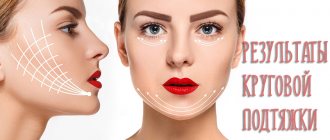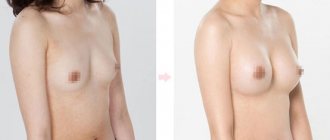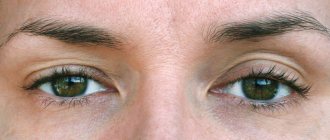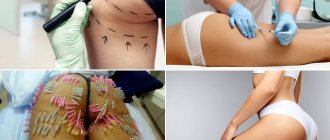What is rhytidectomy
A circumferential facelift (rhytidectomy) is not a cosmetic procedure, but a major operation.
And you should resort to this truly radical method of rejuvenation only when other methods no longer help. Very often it is enough to perform correction only in a single area - for example, removing a double chin or doing blepharoplasty. But when it is necessary to solve several problems at once, such an operation is effective.
Circumferential lifting is usually used to improve your appearance. Thanks to it, skin sagging, jowls, the depth of nasolabial folds and age wrinkles are reduced. It also helps get rid of double chin.
How to do a circular facelift:
- The skin is redistributed.
- Excess skin is trimmed.
- The muscles responsible for facial expressions are strengthened.
- A clearly defined facial contour is formed.
After the operation is completed, the patient's neck and cheeks acquire a more pronounced contour, the chin and cheekbones become sharper. The skin is rejuvenated and gains the desired elasticity.
Advantages
What is a classic circular facelift? In the early 2000s, it suggested a simple detachment of the skin. The entire load fell on the area where the sutures were placed.
The results obtained lasted only up to 2 years. Moreover, ugly scars negated the entire lifting effect. Today, the main load is distributed on the facial muscles. Therefore, the seams are completely invisible.
The main advantage of a circular lift is its longevity. It lasts for a period of 10 to 15 years. And an equally important plus is that it is able to cope with even the deepest wrinkles and sagging skin.
No cosmetic procedure can provide such an effect. You can have filler injections for years on end and pay impressive sums for them. However, in this case there can be no talk of a radical solution to the problem of age-related changes.
Flaws
Not everyone knows that the effect of a classic circular facelift is quite short-lived. Plastic surgeons, unfortunately, do not always report this.
If you tighten only the skin without affecting the muscles, it will soon begin to sag again. You should not expect that after such an operation a woman will remain young for another 10-15 years.
The disadvantages include a fairly long rehabilitation period (about three weeks). In addition, often the result of lifting is more or less very different from the predicted one.
A favorable outcome largely depends on the skill of the surgeon. But even the most qualified doctor cannot guarantee that nerve endings will not be damaged or any other complication will not arise.
Expected effect
A circular facelift can restore your face to a healthy appearance, firm and elastic skin, free from folds, wrinkles and sagging. However, it is important to understand that surgery does not stop the aging process. The maximum duration of rhytidectomy is up to 15 years, but only if you maintain the effect by going to the beauty salon. For example, attend massage or mesotherapy sessions. After 10–15 years, the need for surgery may arise again.
Photo gallery: the result of a circular facelift
Result of a circular facelift
Effect before and after facelift
Result before and after facelift
Result of surgery
Possible complications
Due to medical negligence or complications during operations, the following complications are possible:
- disruption of the facial muscles as a result of injury to the facial nerve;
- hyperextension of the skin or distortion of the face if the muscles and skin were incorrectly fixed;
- incorrectly applied sutures will turn into non-healing scars;
- wound infection, formation of ulcers;
- the appearance of pigment spots in the scar area;
- skin or tissue neurosis in the suture area;
- formation of keloid scars.
The bad news is that in this case, nothing depends on the patient. If he correctly followed all the instructions for preparing for the operation, then all further responsibility for the progress of the operation falls on the doctor. However, this will be of little comfort to the patient if a mistake is made.
Indications
Circular face lifting is indicated primarily for those who want to get rid of two or more of the following signs of aging:
- severe sagging and sagging facial skin;
- deep vertical wrinkles on the forehead and cheeks;
- double chin and “bulldog cheeks”;
- facial asymmetry with sagging skin;
- drooping upper eyelid and bags under the eyes;
- obesity in the cheekbones, cheeks and neck.
In this case, a circular lift will allow you not to go under the surgeon’s scalpel several times, but to correct and rejuvenate your face during one operation. This is its main advantage.
It is advisable to resort to this method of improving your appearance no earlier than 40-45 years old. Until this age, it is recommended to use non-surgical correction methods.
Contraindications
A circumferential lift can only be performed under general anesthesia, which is very stressful for the body. Therefore, before setting a date for surgery, the surgeon will ask you to undergo a short examination to find out if there are any contraindications.
Obstacles to its implementation:
- heart and vascular failure;
- bleeding disorders;
- presence of active viruses and infections;
- any inflammatory processes in the body;
- tendency to form keloid scars;
- oncology and autoimmune diseases;
- hypertension and diabetes mellitus 2-3 degrees;
- dermatological diseases of the face and neck;
- disruptions in the endocrine system;
- serious disorders of the kidneys and liver.
If even one of the listed factors is detected, a good surgeon will categorically prohibit the operation. In addition, two weeks before it you will have to completely stop smoking and drinking alcohol, strong coffee, anticoagulants and vasodilators. This will significantly reduce blood loss and reduce the risk of complications.
Progress of the operation
Immediately before the operation, the doctor examines the patient again and only then allows him to undergo the procedure. A comprehensive facelift is performed under general anesthesia in the following sequence:
- An incision is made from the temporal part to the auricle, going around the ear. Next, the incision is made to the back of the head, which allows the skin to be peeled off in the area of the temples, cheeks, chin and neck.
- The surgeon carefully and precisely stretches the muscular aponeurotic layer.
- If necessary, he performs liposuction to remove excess fat or, conversely, adds fat tissue if it is deficient.
- Next, the doctor redistributes the skin and removes excess skin.
- Using special traction, the surgeon secures the skin in the desired position and applies sutures.
- The final stage is applying a postoperative dressing.
The operation can last from one and a half to four hours.
Its cost will fluctuate around 200–300 thousand, depending on the materials used, the amount of work done, the clinic and hospital stay. If you want to see a well-known surgeon, you will have to pay extra for the doctor’s “name,” so the price will be higher.
One of the most important steps is choosing a good surgeon. The main thing here is not to make a mistake. A friend, having decided to take this step, began searching for a doctor on the Internet. I found the surgeon’s Instagram account. There was a complete set: photos, characteristics, reviews and average cost of services. She even agreed to meet with him, but the day before the consultation he did not answer calls, and the profile was deleted. It turned out that many women suffered because of his negligence and turned to the police for help.
Video: facelift process with detailed explanations by the surgeon
Tightening methods
Many people think of a facelift as making incisions and removing excess skin. However, there is another lifting option - it is performed without surgery.
The surgical method, as already mentioned, involves cutting the skin in the hair growth area or the chin area. The doctor then tightens the skin.
The non-surgical method does not involve any incisions. Tightening is provided by injections of various fillers. Gel-like substances fill subcutaneous voids. As a result, the skin tightens and unevenness and wrinkles disappear.
Both methods give a good effect. The patient makes the decision about which one to prefer together with the doctor.
Types of surgical lifting
The type of surgical circular facelift is determined individually. The main factor influencing decision-making is the severity of age-related changes in a particular department.
In cosmetic facial surgery, there are 3 main problem areas that should be given special attention:
- top;
- average;
- lower
A circular lift is a complex of surgical measures. It affects all the mentioned areas at the same time.
The following types of lifting are very popular:
- SMAS;
- deep;
- endoscopic.
Let's look at each of them in more detail.
SMAS
This type of surgical correction is the most labor-intensive. At the same time, this is an improved and modernized version. One of the latest new products.
If you have opted for SMAS lifting, the doctor will slightly lift and carefully secure the layer of muscles under the skin, as well as the subcutaneous tissue, in a new position.
During the operation the following are tightened:
- brows;
- forehead;
- middle and lower areas of the face;
- neck.
This procedure is intended for those who have already crossed the 45-year mark, but have maintained satisfactory skin condition. Positive comments from patients indicate the effectiveness of such a facelift and the relative ease of rehabilitation.
Deep
A deep lift is relevant if age-related changes have already left quite noticeable marks on the skin. Especially in the middle zone - in its cheekbone part.
This correction method is a cardinal one. After all, during the surgical intervention, the deep layers of the skin of the face are affected.
This type of lifting has minimal impact on microcirculation in tissues. This significantly reduces the risk of complications due to circulatory problems.
The price of such a facelift is quite high. However, the resulting effect is undoubtedly worth the money.
Endoscopic
The endoscopic type of facial lifting allows you to eliminate tissue defects using a minimally invasive method. The absence of long skin incisions ensured its high popularity.
To perform this tightening, the doctor uses a small, thin probe equipped with a video camera and a light bulb. It can be safely done even by a bald man. There will be no scarring.
The advantage of this type of lifting is an easier recovery period and an almost complete absence of complications. But the result obtained will last only 1.5-2 years. This is significantly less when compared with a classic circular lift.
Types of circular lifting
Usually, for plastic surgery, the face is figuratively divided into 3 problem areas: upper, middle and lower.
In the case of circular plastic surgery, the lift affects all 3 zones at once. However, if in some area the changes are more pronounced, then emphasis is placed on it:
- Upper zone lift. This is the forehead, eyebrows, eyelids, temples. Lifting the temporal area and eyebrows is called temparoplasty, and the eyelids are called blepharoplasty. Here, endoscopic lifting is most often performed: to make the stitches almost invisible, they operate through small punctures using a microscopic video camera, which displays the image on the screen.
- Mid zone lift. This is the skin under the eyes, nose, cheeks, cheekbones, corners of the mouth. A small incision is made under the lower eyelid, through which the tissue is pulled vertically. There are other names for such mid-plasty – check-lifting or midface.
- Lower zone lift. Here work is carried out on the chin and neck area, jowls, and lower lip. Here either an endoscopic approach or several incisions are made under the chin along the contour and along the lower hairline. Lifting threads are passed through the incisions and used to fix the chin tissue in the desired position.
A circular facelift is performed in several ways:
- Classic scalpel surgery. I described above how it is done: they give anesthesia, excise excess skin and sew it in the desired position. Here it is necessary to go to the hospital - for several days after the operation (on average 5), the patient is observed, the necessary medications are administered to him and a clean bandage is applied daily.
The cost of the operation is decent - from 100 to 600 thousand rubles.
- Thread lifting. This operation is usually performed without general anesthesia - with local anesthesia. Special threads are threaded through small incisions, and a special frame is formed from them that will support the tissue. The incisions are then closed with stitches. The whole procedure lasts an hour on average, and after 4 hours you can go home.
The price ranges from 10 to 200 thousand rubles.
- Tightening by radio waves. This operation does not require any incisions or punctures, but may require up to 3 sessions. The tissues are heated by electromagnetic waves, causing microburns, which tighten the skin. Everything is done under local anesthesia.
The asking price is 3-50 thousand rubles.
- Laser lifting. The laser acts similarly to radio waves - it penetrates deep into the skin and creates microtraumas in the fibers. This provokes the body to intensively produce collagen and tightens tissue.
This procedure costs about 10-100 thousand.
The last two methods are considered the safest among plastic surgeries, since they do not require incisions or stitches, and the recovery period is faster.
The results of any plastic surgery do not last forever - the effect lasts on average 5-10 years, since the causes of sagging tissues (impaired blood circulation and tissue metabolism, poor drainage of toxins with lymph, muscle spasms) are not eliminated. Everything is disguised only externally.
Execution technique
Some women are afraid to undergo a circular facelift because they have little idea of how the operation is performed in modern conditions. And they think that everything is the same as twenty years ago.
The use of laser technologies and new methods have made plastic surgery much less traumatic. They allow you to make do with a few small cuts, the marks of which will be almost invisible.
At the preliminary consultation, a computer simulation of the expected result from a circular lift is required. It is this that helps the doctor determine the locations of future incisions as accurately as possible.
Typically, cuts are made behind the ears, along the hairline and under the chin. Therefore, even in the first time after the intervention, they can be very easily hidden.
A good clinic will definitely show a video of how the operation will take place. The doctor will make sure that the patient feels calmer, knowing exactly what he will have to endure.
After administering anesthesia, the surgeon carefully separates the facial skin from the subcutaneous tissue. This process must be performed as carefully as possible. Therefore, the duration of the operation is difficult to predict in advance - it can last from 2 to 5 hours.
If necessary, liposuction is performed at the same time. Then the skin is stretched, excess is removed, and fixation is performed with cosmetic sutures using high-quality thread.
Finally, a sterile dressing is applied. The patient can now be transferred to the intensive care unit. Not for long - just to make sure that after coming out of anesthesia everything is fine with him.
Rehabilitation
The rehabilitation period usually consists of three stages:
- Postoperative – from 1 to 3 days. Depends on the complexity of the correction performed. It occurs only in a hospital setting.
- Active recovery – from 5 to 14-21 days. Stitches are removed, bruises and swelling disappear. Takes place at home.
- Complete rehabilitation takes up to 6 months. The sutures are healing. A new facial oval is formed. The skin again fuses with the subcutaneous fat layer.
Each stage is associated with the mandatory implementation of the instructions given by the doctor. The quality of the recovery itself and the patient’s condition depend on this.
Complications
If complications arise after surgery, they usually become noticeable already during the active recovery period. Therefore, it is very important to come for consultations regularly and immediately inform the doctor about all negative aspects.
Among the most common complications are:
- loss of skin sensitivity in any area;
- asymmetry of the face, unclosed eyelids;
- long-lasting tissue swelling;
- inflammation and suppuration of sutures.
To prevent the development of such troubles, for at least a month after the operation you should not appear in the open sun, play sports, or visit the sauna or swimming pool. It is also necessary to strictly follow all doctor’s instructions issued for the rehabilitation period.
Postoperative care
Circumferential facelift is a complex operation. Therefore, aftercare must be strict.
It is strictly forbidden to expose your facial skin to direct water. You need to be especially careful with the areas where the seams are located. You can't wash your face as usual. To clean, use slightly moistened cotton sponges or swabs.
In the first 2-3 weeks after plastic surgery, it is prohibited to visit the solarium, sauna and bathhouse. It is also unacceptable to take a hot bath.
The skin of the face in the postoperative period requires careful care. It needs mandatory cleansing, nutrition and protection. It is recommended to use moisturizing masks and special products for rejuvenation and lifting.
Cost of rhytidectomy
The price of a circular facelift directly includes the cost of the operation, hospital stay and doctor’s observation in the first 2-3 days after plastic surgery. In addition, it includes payment for anesthesia and a special mask that is put on the face after the intervention.
A set of tests and medical procedures that are performed after surgery are usually paid for separately. However, in some clinics they may be included in the total cost.
In Moscow, you will have to pay from 250 to 300 thousand rubles for a circular facelift. A higher price indicates the status of the clinic or the eminent surgeon who will operate.
Features of rehabilitation after a circular facelift
The timing and complexity of a patient’s recovery after a circular facelift depends on how it was performed.
A common rule is a month-long ban on sunbathing and solariums. In the first 2 weeks, under no circumstances should you visit the bathhouse or sauna. It is strongly recommended to stop using any care and decorative cosmetics for 2-3 days. Helpful tips on how to survive a facelift without problems:
- Thread
. The acute period lasts 3 days. This is how long the retaining patches remain on the face. During this time, you should chew your food carefully. Active mouth movements are not allowed. To avoid infection, punctures should be treated with a 3% solution of hydrogen peroxide 3-4 times a day. For pain relief, pieces of ice can be applied to the treated area. On days 5-7, to speed up recovery, it is recommended to use ultrasound and perform phonophoresis. The bandage and patch are removed after about a week. In a month all restrictions will be lifted. - Laser
. Immediately after the procedure, the patient experiences swelling at the site of exposure to the beam, which disappears within 3-5 days. It is advisable to spend the first night in the hospital. Within 2 weeks, a feeling of facial stiffness and heaviness may appear. For effective rehabilitation, it is important to give up alcohol, monitor blood pressure and not take a hot bath/shower. If there are noticeable bruises, you can use special ointments and gels - Indovazin, Troxevasin, Express bruise. - Radio wave
. In this case, there is no rehabilitation period as such. The patient can leave the hospital immediately and return to their previous lifestyle. In the first 3 days after the procedure, there is a high probability of redness and swelling of the skin, which go away on their own. - Surgical
. A lift in this way requires a 4-week recovery course. Ideally, the patient should stay in the hospital for at least 2-3 days. In the first 5 days it is forbidden to use cosmetics. From time to time it is necessary, at the discretion of the doctor, to change the dressing. The stitches are removed after 1-2 weeks. To speed up the healing process of wounds, lymphatic drainage massage and physiotherapeutic procedures can be prescribed.
What is a circular facelift - watch the video: A circular facelift is an excellent alternative to Botox and mesotherapy. It allows you to lose as much as 5-10 years painlessly and without health risks. It is very important that after such a procedure there are never any serious complications. Feel free to choose it and you won’t go wrong!










